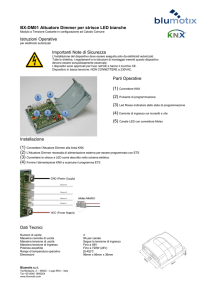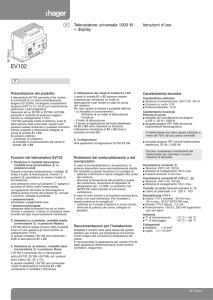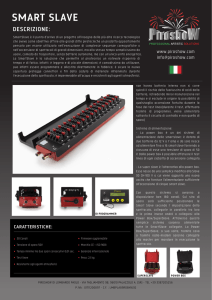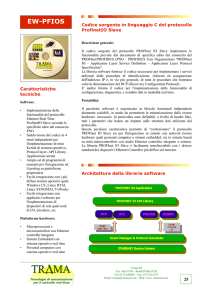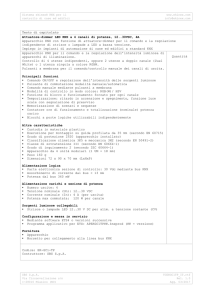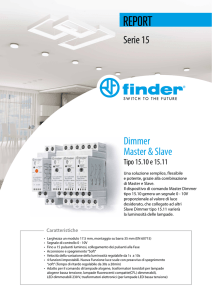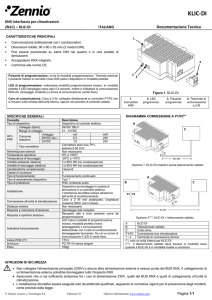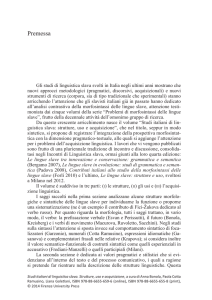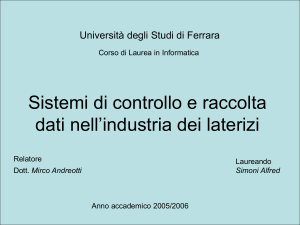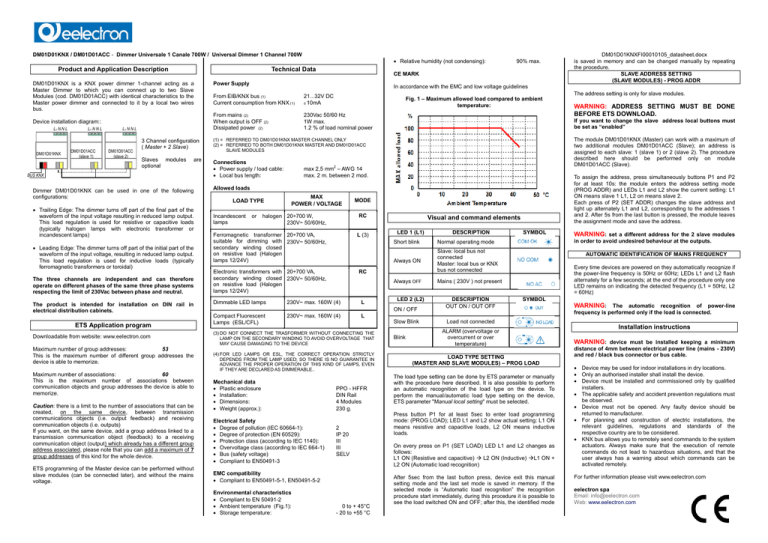
DM01D01KNX / DM01D01ACC - Dimmer Universale 1 Canale 700W / Universal Dimmer 1 Channel 700W
Relative humidity (not condensing):
Product and Application Description
Technical Data
DM01D01KNX is a KNX power dimmer 1-channel acting as a
Master Dimmer to which you can connect up to two Slave
Modules (cod. DM01D01ACC) with identical characteristics to the
Master power dimmer and connected to it by a local two wires
bus.
Device installation diagram::
L1 N N L
DM01D01KNX
L1 N N L
DM01D01ACC
(slave 1)
L1 N N L
DM01D01ACC
(slave 2)
3 Channel configuration
( Master + 2 Slave)
Slaves modules
optional
are
BUS KNX
Dimmer DM01D01KNX can be used in one of the following
configurations:
Trailing Edge: The dimmer turns off part of the final part of the
waveform of the input voltage resulting in reduced lamp output.
This load regulation is used for resistive or capacitive loads
(typically halogen lamps with electronic transformer or
incandescent lamps)
Leading Edge: The dimmer turns off part of the initial part of the
waveform of the input voltage, resulting in reduced lamp output.
This load regulation is used for inductive loads (typically
ferromagnetic transformers or toroidal)
The three channels are independent and can therefore
operate on different phases of the same three phase systems
respecting the limit of 230Vac between phase and neutral.
The product is intended for installation on DIN rail in
electrical distribution cabinets.
ETS Application program
Downloadable from website: www.eelectron.com
Maximum number of group addresses:
53
This is the maximum number of different group addresses the
device is able to memorize.
Maximum number of associations:
60
This is the maximum number of associations between
communication objects and group addresses the device is able to
memorize.
Caution: there is a limit to the number of associations that can be
created, on the same device, between transmission
communications objects (i.e. output feedback) and receiving
communication objects (i.e. outputs)
If you want, on the same device, add a group address linked to a
transmission communication object (feedback) to a receiving
communication object (output) which already has a different group
address associated, please note that you can add a maximum of 7
group addresses of this kind for the whole device.
ETS programming of the Master device can be performed without
slave modules (can be connected later), and without the mains
voltage.
90% max.
CE MARK
Power Supply
In accordance with the EMC and low voltage guidelines
From EIB/KNX bus (1)
Current consumption from KNX (1)
21...32V DC
≤ 10mA
From mains (2)
When output is OFF (2)
Dissipated power (2)
230Vac 50/60 Hz
1W max.
1.2 % of load nominal power
Fig. 1 – Maximum allowed load compared to ambient
temperature:
Connections
Power supply / load cable:
Local bus length:
max 2,5 mm2 – AWG 14
max. 2 m. between 2 mod.
or
MAX
POWER / VOLTAGE
To assign the address, press simultaneously buttons P1 and P2
for at least 10s: the module enters the address setting mode
(PROG ADDR) and LEDs L1 and L2 show the current setting: L1
ON means slave 1 L1, L2 on means slave 2.
Each press of P2 (SET ADDR) changes the slave address and
light up alternately L1 and L2, corresponding to the addresses 1
and 2. After 5s from the last button is pressed, the module leaves
the assignment mode and save the address.
L (3)
Ferromagnetic transformer 20÷700 VA,
suitable for dimming with 230V~ 50/60Hz,
secondary winding closed
on resistive load (Halogen
lamps 12/24V)
Visual and command elements
LED 1 (L1)
Normal operating mode
Always ON
Slave: local bus not
connected
Master: local bus or KNX
bus not connected
Always OFF
230V~ max. 160W (4)
L
LED 2 (L2)
ON / OFF
Compact Fluorescent
Lamps (ESL/CFL)
230V~ max. 160W (4)
Slow Blink
(4) FOR LED LAMPS OR ESL, THE CORRECT OPERATION STRICTLY
DEPENDS FROM THE LAMP USED; SO THERE IS NO GUARANTEE IN
ADVANCE THE PROPER OPERATION OF THIS KIND OF LAMPS, EVEN
IF THEY ARE DECLARED AS DIMMERABLE..
Electrical Safety
Degree of pollution (IEC 60664-1):
Degree of protection (EN 60529):
Protection class (according to IEC 1140):
Overvoltage class (according to IEC 664-1)
Bus (safety voltage)
Compliant to EN50491-3
PPO - HFFR
DIN Rail
4 Modules
230 g.
2
IP 20
III
III
SELV
EMC compatibility
Compliant to EN50491-5-1, EN50491-5-2
Environmental characteristics
Compliant to EN 50491-2
Ambient temperature (Fig.1):
Storage temperature:
SYMBOL
AUTOMATIC IDENTIFICATION OF MAINS FREQUENCY
Every time devices are powered on they automatically recognize if
the power-line frequency is 50Hz or 60Hz; LEDs L1 and L2 flash
alternately for a few seconds; at the end of the procedure only one
LED remains on indicating the detected frequency (L1 = 50Hz, L2
= 60Hz)
Mains ( 230V ) not present
DESCRIPTION
OUT ON / OUT OFF
0 to + 45°C
- 20 to +55 °C
Blink
WARNING: set a different address for the 2 slave modules
in order to avoid undesired behaviour at the outputs.
SYMBOL
WARNING: The automatic recognition of power-line
frequency is performed only if the load is connected.
L
(3) DO NOT CONNECT THE TRASFORMER WITHOUT CONNECTING THE
LAMP ON THE SECONDARY WINDING TO AVOID OVERVOLTAGE THAT
MAY CAUSE DAMAGING TO THE DEVICE
Mechanical data
Plastic enclosure
Installation:
Dimensions:
Weight (approx.):
DESCRIPTION
Short blink
RC
Electronic transformers with 20÷700 VA,
secondary winding closed 230V~ 50/60Hz,
on resistive load (Halogen
lamps 12/24V)
Dimmable LED lamps
MODE
RC
halogen 20÷700 W,
230V~ 50/60Hz,
WARNING: ADDRESS SETTING MUST BE DONE
BEFORE ETS DOWNLOAD.
The module DM01D01KNX (Master) can work with a maximum of
two additional modules DM01D01ACC (Slave); an address is
assigned to each slave: 1 (slave 1) or 2 (slave 2). The procedure
described here should be performed only on module
DM01D01ACC (Slave).
Allowed loads
LOAD TYPE
The address setting is only for slave modules.
If you want to change the slave address local buttons must
be set as “enabled”
(1) = REFERRED TO DM01D01KNX MASTER CHANNEL ONLY
(2) = REFERRED TO BOTH DM01D01KNX MASTER AND DM01D01ACC
SLAVE MODULES
Incandescent
lamps
DM01D01KNXFI00010105_datasheet.docx
is saved in memory and can be changed manually by repeating
the procedure.
SLAVE ADDRESS SETTING
(SLAVE MODULES) - PROG ADDR
Load not connected
ALARM (overvoltage or
overcurrent or over
temperature)
LOAD TYPE SETTING
(MASTER AND SLAVE MODULES) – PROG LOAD
The load type setting can be done by ETS parameter or manually
with the procedure here described. It is also possible to perform
an automatic recognition of the load type on the device. To
perform the manual/automatic load type setting on the device,
ETS parameter "Manual local setting" must be selected.
Press button P1 for at least 5sec to enter load programming
mode: (PROG LOAD); LED L1 and L2 show actual setting: L1 ON
means resistive and capacitive loads, L2 ON means inductive
loads.
On every press on P1 (SET LOAD) LED L1 and L2 changes as
follows:
L1 ON (Resistive and capacitive) L2 ON (Inductive) L1 ON +
L2 ON (Automatic load recognition)
After 5sec from the last button press, device exit this manual
setting mode and the last set mode is saved in memory. If the
selected mode is “Automatic load recognition” the recognition
procedure start immediately, during this procedure it is possible to
see the load switched ON and OFF; after this, the identified mode
Installation instructions
WARNING: device must be installed keeping a minimum
distance of 4mm between electrical power line (mains - 230V)
and red / black bus connector or bus cable.
Device may be used for indoor installations in dry locations.
Only an authorised installer shall install the device.
Device must be installed and commissioned only by qualified
installers.
The applicable safety and accident prevention regulations must
be observed.
Device must not be opened. Any faulty device should be
returned to manufacturer.
For planning and construction of electric installations, the
relevant guidelines, regulations and standards of the
respective country are to be considered.
KNX bus allows you to remotely send commands to the system
actuators. Always make sure that the execution of remote
commands do not lead to hazardous situations, and that the
user always has a warning about which commands can be
activated remotely.
For further information please visit www.eelectron.com
eelectron spa
Email: [email protected]
Web: www.eelectron.com
DM01D01KNX / DM01D01ACC - Dimmer Universale 1 Canale 700W / Universal Dimmer 1 Channel 700W
Dati tecnici
Descrizione del prodotto e suo funzionamento
Il dispositivo DM01D01KNX è un dimmer KNX di potenza ad 1
canale con funzione di Dimmer Master a cui è possibile collegare
fino a due moduli Slave (cod. DM01D01ACC) aventi le stesse
caratteristiche di potenza del dimmer master e collegate ad esso
mediante un bus locale a due fili.
Schema del dispositivo:
L1 N N L
DM01D01KNX
L1 N N L
DM01D01ACC
(slave 1)
Alimentazione e consumi
Da bus EIB/KNX (1)
Corrente assorbita da bus KNX(1)
Da rete (2)
Consumo con uscita OFF
Potenza dissipata (2)
DM01D01ACC
(slave 2)
Gli slave sono opzionali
21..32V DC
≤ 10mA
230Vac 50/60 Hz
1W max.
1.2 % potenza nominale
carico collegato
(2)
L1 N N L
Configurazione 3 canali
( Master + 2 Slave)
Condizioni di impiego
Secondo norme EN 50491-2
Temperatura operativa (Fig. 1):
Temperatura di stoccaggio:
Umidità relativa (non condensante):
0 ÷ +45°C
- 20 ÷ +55 °C
max. 90%
Marcatura CE
Conforme alla direttiva CE (edilizia abitativa e industriale),
direttiva sulla bassa tensione
FIg. 1 - Declassamento del carico massimo ammesso in
funzione della temperature ambiente:
Il modulo DM01D01KNX (Master) può essere affiancato da un
massimo di altri due moduli aggiuntivi DM01D01ACC (Slave) cui
va assegnato un indirizzo 1 (slave 1) o 2 (slave 2). La procedura
qui descritta va eseguita solo sui moduli DM01D01ACC (Slave).
Carichi ammissibili
TIPO DI CARICO
POTENZE/TENSIONI
MAX
MODO
Lampade a incandescenza 20÷700 W,
o alogene:
230V~ 50/60Hz,
RC
Trasformatori ferromagnetici 20÷700 VA,
con
avvolgimento 230V~ 50/60Hz,
secondario chiuso su carico
resistivo (Lampade alogene
a 12/24V)
L (3)
RC
I 3 canali sono indipendenti e possono pertanto operare
ciascuno su fasi diverse di sistemi trifase purché sia
rispettato il limite di 230Vac tra una fase e neutro .
Trasformatori elettronici con 20÷700 VA,
avvolgimento
secondario 230V~ 50/60Hz,
chiuso su carico resistivo
(Lampade
alogene
a
12/24V)
Il prodotto si intende dedicato all’installazione su barra DIN
in quadri elettrici di distribuzione BT.
Lampade LED dimmerabili
Trailing Edge: la regolazione del carico si ottiene
intervenendo nella parte finale della forma d’onda della
tensione in ingresso e viene utilizzato per carichi capacitivi o
resistivi (tipicamente lampade alogene con trasformatore
elettronico o lampade a incandescenza)
Leading Edge: la regolazione del carico si ottiene
intervenendo nella parte iniziale della forma d’onda della
tensione in ingresso e viene utilizzato per carichi induttivi
(tipicamente trasformatori ferromagnetici o toroidali)
Programma applicativo ETS
Posizione indicatori ed elementi di comando
230V~ max. 160W (4)
L
Lampade
a
risparmio 230V~ max. 160W (4)
energetico (ESL/CFL)
L
Scaricabile dal sito: www.eelectron.com
Numero massimo indirizzi di gruppo
53
Corrisponde al numero massimo di indirizzi di gruppo diversi che il
dispositivo è in grado di memorizzare.
Numero massimo associazioni
60
Corrisponde al numero massimo di associazioni tra oggetti di
comunicazione e indirizzi di gruppo che il dispositivo può
memorizzare.
Attenzione : esiste un limite al numero di associazioni che si
possono creare, sullo stesso dispositivo, tra oggetti di
comunicazione in trasmissione (per esempio gli stati delle uscite)
e in ricezione (per esempio le uscite). Qualora si voglia associare
un indirizzo di gruppo usato su un oggetto di comunicazione in
trasmissione (uno stato) , ad un oggetto di comunicazione in
ricezione
(una uscita) che ha già un indirizzo di gruppo
precedentemente associato si ricorda che è possibile aggiungere
un massimo di 7 indirizzi di gruppo di questo tipo sull’intero
dispositivo.
La programmazione del dispositivo Master tramite ETS può
essere eseguita anche in assenza dei moduli slave (che possono
quindi essere collegati successivamente) e senza collegare
necessariamente la tensione di rete.
(3) !! NON COLLEGARE MAI IL TRASFORMATORE SENZA PRIMA AVER
COLLEGATO
IL
CARICO
SUL
SECONDARIO
PER
EVITARE
SOVRATENSIONI DISTRUTTIVE PER L’APPARECCHIO
(4) PER LE LAMPADE A LED O ESL, IL CORRETTO FUNZIONAMENTO
DIPENDE STRETTAMENTE DAL TIPO DI LAMPADA UTILIZZATA;
PERTANTO NON È POSSIBILE GARANTIRE IN ANTICIPO IL CORRETTO
FUNZIONAMENTO DI QUESTO TIPO DI LAMPADE, ANCHE SE SONO
DICHIARATE COME DIMMERABILI.
Dati meccanici
Involucro in materiale plastico
Montaggio:
Dimensioni:
Peso (circa):
Sicurezza elettrica
Grado inquinamento (IEC 60664-1):
Grado protezione (EN 60529):
Classe di protezione (secondo IEC 1140):
Classe di sovratensione :
Bus: tensione di sicurezza
Soddisfa EN50491-3
PPO - HFFR
Guida DIN
4 Moduli
230 g.
2
IP 20
III
III
SELV
LED 1 (L1)
Breve
lampeggio
DESCRIZIONE
Acceso
fisso
Slave: NO connessione sul
bus locale
Master: NO connessione sul
bus locale o bus KNX
Spento
Alimentazione 230V assente
LED 2 (L2)
DESCRIZIONE
On /Off
Lampeggio
lento
Uscita OFF / ON
Lampeggio
SIMBOLO
Funzionamento regolare
Per assegnare l’indirizzo, premere contemporaneamente i pulsanti
P1 e P2 per almeno 10s: il modulo entra in modo assegnazione
indirizzo (PROG ADDR) e i LED L1 e L2 mostrano l’impostazione
attuale: L1 acceso indica slave 1, L2 acceso indica slave 2.
Ad ogni pressione di P2 (SET ADDR) si accendono
alternativamente L1 e L2, corrispondenti agli indirizzi 1 e 2. Dopo
5s dall’ultima pressione del pulsante, il modulo esce dalla
modalità assegnazione e salva l’indirizzo impostato.
ATTENZIONE: impostare indirizzi diversi per i moduli slave
al fine di evitare comportamenti indesiderati sulle uscite.
RICONOSCIMENTO AUTOMATICO FREQUENZA RETE
SIMBOLO
Carico non collegato
Attiva protezione
sovratensione, sovracorrente
o sovratemperatura
IMPOSTAZIONE DEL TIPO DI CARICO
(MODULI MASTER E SLAVE) – PROG LOAD
L’impostazione del tipo di carico può essere effettuata mediante
parametro ETS oppure manualmente con la procedura qui
descritta. in questo caso è anche possibile far eseguire al
dispositivo il riconoscimento automatico del tipo carico. Per poter
eseguire la procedura di impostazione manuale sul dispositivo è
necessario che in ETS sia selezionato il parametro “impostazione
manuale locale”
Premere P1 per almeno 5sec: : il modulo entra in modo
programmazione carico (PROG LOAD) e i LED L1 e L2 mostrano
l’impostazione corrente: L1 acceso indica impostazione per carichi
capacitivi e resistivi, L2 acceso indica impostazione per carichi
induttivi.
Requisiti EMC
Soddisfa EN50491-5-1, EN50491-5-2
L’impostazione dell’indirizzo è riservata ai soli moduli slave.
Se si vuole cambiare un indirizzo slave il parametro “pulsanti
locali” va impostato come “abilitati”
max. 2,5 mm2 – AWG 14
max. 2 metri tra 2 moduli
BUS KNX
Il dispositivo DM01D01KNX può essere utilizzato in una delle
seguenti configurazioni:
IMPOSTAZIONE DELL’INDIRIZZO
(MODULI SLAVE) - PROG ADDR
ATTENZIONE: L’IMPOSTAZIONE DELL’INDIRIZZO VA
ESEGUITA PRIMA DEL DOWNLOAD ETS.
(1) = RIFERITO AL SOLO CANALE MASTER DM01D01KNX
(2) = RIFERITO AI CANALI MASTER DM01D01KNX E SLAVE DM01D01ACC
Connessioni
Sezione cavo per alim./carico:
Lunghezza bus locale:
DM01D01KNXFI00010105_datasheet.docx
Dopo 5sec dall’ultima pressione del pulsante, il modulo esce dalla
impostazione e salva il modo selezionato. Nel caso sia stato
selezionato “Autoapprendimento”, avviene la procedura di test del
carico, durante la quale si eseguono accensioni dello stesso; al
termine di questa procedura viene salvata la configurazione
appresa automaticamente dal dispositivo.
Ad ogni pressione di P1 (SET LOAD) i LED cambiano stato con il
seguente significato:
L1 ON (Capacitivo e resistivo) L2 ON (Induttivo) L1 ON + L2
ON (Autoapprendimento del carico)
Ad ogni accensione i dispositivi riconoscono automaticamente se
la frequenza di rete è 50Hz oppure 60Hz; i led L1 ed L2
lampeggiano alternativamente per qualche secondo; al termine
della procedura uno dei due led rimane acceso indicando la
frequenza rilevata (L1 =50Hz, L2 =60Hz)
ATTENZIONE: La procedura di riconoscimento automatico
della frequenza si attiva solo se il carico è collegato.
Avvertenze per l‘installazione
ATTENZIONE:
Il dispositivo deve essere installato
mantenendo una distanza minima di 4 mm tra le linee in
tensione non SELV (230V ) e i cavi collegati al bus EIB/KNX .
Il dispositivo deve essere installato in ambienti chiusi e asciutti
Il dispositivo deve essere installato e messo in servizio solo da
installatori abilitati e qualificati
Per la progettazione e la realizzazione degli impianti elettrici
devono essere osservati regolamenti e norme vigenti
Devono essere osservate le norme in vigore in materia di
sicurezza e prevenzione antinfortunistica.
L’apparecchio non deve essere aperto. Eventuali apparecchi
difettosi devono essere fatti pervenire alla sede competente.
Il bus KNX permette di inviare comandi da remoto all’impianto.
Verificare sempre che l’esecuzione di tali comandi non crei
situazioni pericolose e che l’utente abbia sempre segnalazione
di quali comandi possono essere attivati a distanza.
Per ulteriori informazioni visitare: www.eelectron.com
eelectron spa
Email: [email protected]
Web: www.eelectron.com


